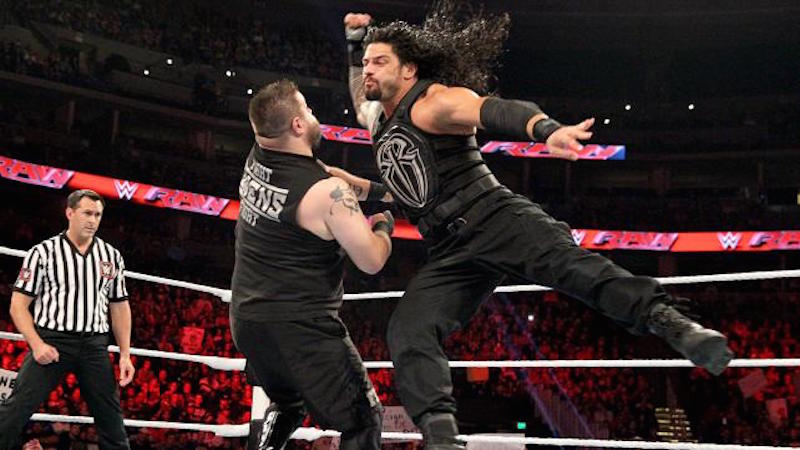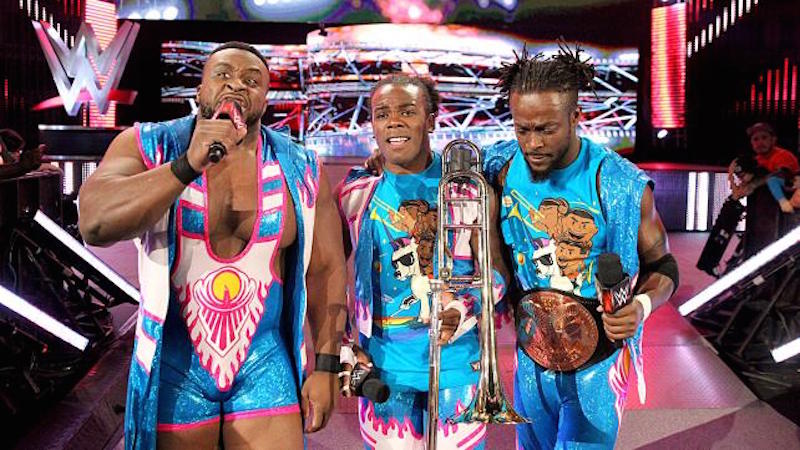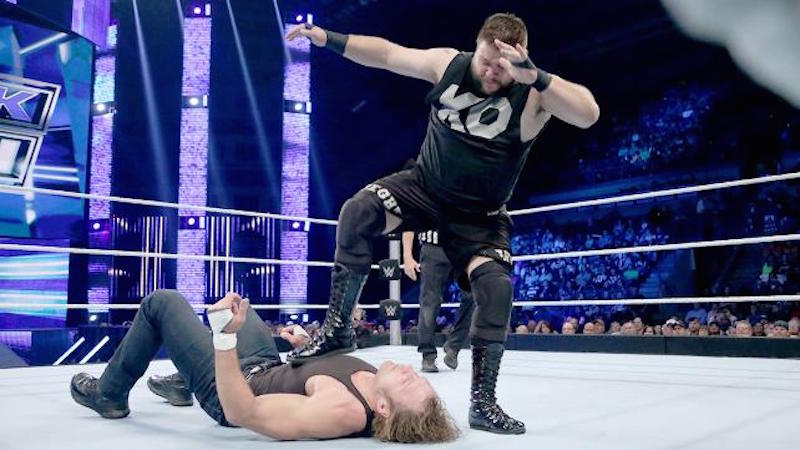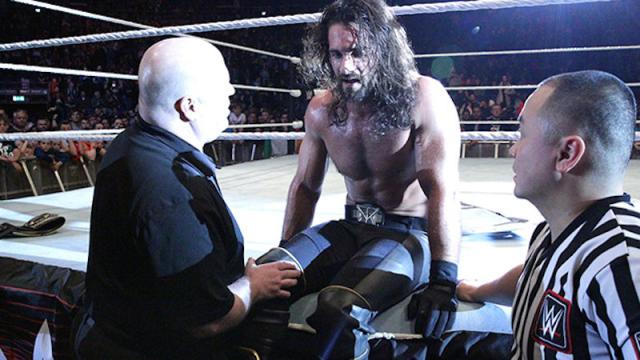Pro wrestling injuries suck for the wrestlers who get hurt. For everyone else, they are, weirdly, a good thing. That’s true even this week as one of the WWE’s best performers, its top champion Seth Rollins, suffered multiple knee injuries during a non-televised match in Ireland and will be shelved for the next six to nine months.
It may seem rude to take this as good news. On one level, of course it’s not, and I feel for the guy who was doing a great job as WWE champ. There’s certainly sympathy due to a performer like Rollins, who started the year wrestling the potential match of the year against then-champion Brock Lesnar and perennial star challenger John Cena, and who emerged as the top bad guy in WWE during a title reign that began in late March with the perfectly scripted finale of Wrestlemania 31. Rollins is a brilliant talent with a bright future. He has deserved his success and, given his youth, his verbal talents and athleticism, will likely come back better and more appreciated by fans than ever.
Pro wrestling, as some will gleefully remind you, is not sports. Injuries are not devastating events that will wreck a team or sink a season. In pro wrestling, dramatic storyline-ruining breaks, tears and contusions bode many good things for everyone who isn’t hurt. They free up a spot on the card. They give other talents an opportunity to thrive and management a mandate to enable that. Because pro wrestling is basically a popularity contest in terms of who is scripted to succeed, a star getting injured isn’t really like a quarterback getting benched with a broken arm. It’s more like a top presidential candidate backing out due to scandal. Suddenly everyone else gets a new chance, the storylines get rewritten and everyone can speculate about who is going to make a surprise return or debut.
Bad injuries also set up the inevitable, dramatic comeback of the injured wrestler: the shock return of John Cena as the mystery 30th entry at the 2008 Royal Rumble, the cathartic comeback of HHH in 2002 after a quad tear. Wrestling has no offseason, so in the sickest of ways, injuries help a wrestler seem fresh again. Injured wrestlers, mind you, rarely return as bad guys. People are usually pretty pumped to have them back.
Most importantly, though, major injuries in pro wrestling put fans and the powers that be in the most unusual of spots: the same page. The WWE writers’ old plans for what was going to happen next in their weekly athletic soap opera go out the window. Suddenly everyone is a so-called fantasy booker and anything is possible. Who will be the next champ? Technically, right now, it could be anyone, including wrestlers no one was considering just a few days ago.

The meta-drama of watching pro wrestling is seeing how your fantasy version of events compares to the one playing out in front of you. You hope that the wrestlers you like get better roles — are given the championship or longer matches. You fear that the wrestlers you like will get treated badly, will be scripted to lose in underwhelming fashion, perhaps in order to elevate some other wrestler that management prefers. Or maybe they will be given a bad storyline. That tension leads to the occasional fan insurrection, when crowds cheer the villain or boo the hero. WWE sometimes exploits this tension, intentionally frustrating fans just enough until they finally give an underdog a victory or finally have a hated hero “turn” and declare that he’s a bad guy. Other times, WWE simply rides fan frustration out, as it has for a decade with Cena, who too many of the company’s young fans love for the company to portray him as anything but a conquering hero, despite the number of older fans who jeer him.
The big injuries reset the company’s plans and can trigger the need to script the formerly unthinkable. So, yesterday, when news broke of Rollins’ bad injury, wrestling fans, myself included, already began to dream up the good storylines that could come out of this. And we could do so with that rare comfort that the people who write WWE programming are having to do the same thing. We all are dreaming anew.
An injury to a star jolts everyone out of complacency and creates opportunity for something fresh. It has happened so many times before. In 1997, an on-the-rise Steve Austin gets dumped on his head and is shifted to non-wrestling roles on episodes of Monday Night Raw that see him beating up announcers, including owner Vince McMahon, which cements Austin as the ultimate anti-authority star. In more recent years, Cena has been the champion or been portrayed as WWE’s most important performer on their TV show for an inordinate amount of time, leading to refreshing moments on the rare occasions where Cena is out for injury and WWE has to scramble to make other performers seem worthy of the main event.

WWE was actually doing a pretty good job this year refreshing its roster and providing some plot twists. Its elevation of Rollins to world champion put a new talent at the top of its hierarchy. It discovered greatness in three under-used wrestlers who were repackaged as the dorky New Day, an act that benefits from the youthful cleverness of the creative, in-joke-savvy trio of wrestlers behind it. WWE finally started building a women’s division based more on athletic performance than on hotness. It vaulted Kevin Owens, a longtime indie wrestler, to near-main event status as one of the company’s top villains.
WWE was nevertheless still stumbling in recent months and airing some very boring episodes of TV. It’s been playing an ok hand badly. It lost an ace after a second major injury in a 12 month span shelved Bryan, one of its best and most popular performers, last spring. It’s unclear if he’ll even return to a wrestling role. The company’s attempts to promote Roman Reigns to the top fizzled early this year, as fans got behind Bryan and Lesnar instead, and only now has Reigns’ performances begun to win loud appreciation from fans. The women’s division has sputtered despite being loaded with talent as WWE weirdly focused on presenting those performers into a seemingly endless three-way factional rivalry instead of showcasing any one of them as a formidable competitor.
Fans have rightfully expected better, but now isn’t usually the time when WWE shows get better. Autumn is typically the worst season for WWE programming, because the company seems to just surrender to the ratings pull of Monday Night Football and coasts with mediocre installments of Monday Night Raw. WWE tends to bide its time until January, when the Royal Rumble event begins the so-called road to Wrestlemania. Suddenly WWE scripts begin to betray a greater amount of creative effort.
Now, however, there is an injury and a need to immediately shake things up. That creates compelling uncertainty and makes the next couple of weeks of WWE programming exceptionally relevant TV viewing. WWE has already announced that Rollins has been stripped of the title and that a tournament to crown a new champion will take place at the Survivor Series event on Sunday November 22 in Atlanta. It’s not clear if the entire tournament will happen during that event, but WWE usually will at least do semi-finals and finals — and sometimes even quarter-finals — of a major tournament all in one evening.
WWE had been building this year’s Survivor Series around the idea of the 25th anniversary of the debut of the still-active Undertaker and had already scripted the ascent of Reigns to be the number one contender to challenge for Rollins’ title at the event. Presumably, either Reigns would dethrone Rollins or lose. Undertaker seemed slated for some sort of revenge plot, allied with longtime storyline brother Kane against the young villain team The Wyatt Family.
Most or all of that is probably no longer going to happen. Instead the next two weeks of WWE’s Raw and Smackdown shows are likely to be dominated by the set-up for the world title tournament. For fans, that actually should be thrilling. What will WWE do? If they still want Reigns to get the title soon, they’re surely aware that he’s been hurt most when fans can see him being manoeuvred to the top spot. Having him win his way through tournament matches could either win fan respect or trigger backlash at the perceived inevitability.
Some have speculated that the tournament will give WWE reason to stage some shocking returns. I’d be thrilled to see Bryan back, for example, but it beggars belief that a repeatedly-injured wrestler, no matter how healed he is, is going to be brought in to wrestle multiple matches in what is presumably going to be a one-night tournament. It’s equally implausible that the part-time Lesnar wrestles a few matches in a day to be crowned champ. Still, a tournament lets WWE introduce some wildcards and allows them to bring in outside wrestlers to at least make a good showing and imply that anything truly can happen.
WWE could decide to just go nuts and put the world title on their arguably best in-ring wrestler right now, Cesaro, a guy who puts on great matches all the time but isn’t in a current storyline.
They could put the world title on a member of The New Day.
They could celebrate Undertaker’s 25th anniversary by concocting a way to get the belt on him.
They could call CM Punk and beg him to come back (not happening!).
They could do a lot of things. And the funny thing is that one of the less likely things that they will do is put the title on Cena. He’s out right now for personal reasons and, perhaps more importantly, he’s one title win away from tying the great Ric Flair’s record for most world championship reigns, a record that they’d probably like to script more drama into Cena chasing than having him show up and win a tournament.

There is another opportunity in the wake of Rollins’ injury: the need for a new top WWE chief antagonist. Rollins and Reigns had a legit two-year storyline beef involving Rollins repeatedly screwing over Reigns. It was about to pay off in their match. If WWE wants a big enemy for Reigns now, they actually don’t have one. They already had the shallowest pool of villains in recent memory. Because of that, no one is as likely to benefit from Rollins’ injury as Owens, a guy who wasn’t even on the main roster until May and is now — with Rollins out, Rusev injured, Kane turned good, Lesnar too widely cheered, Sheamus played out, and Wyatt still developing — the top full-time bad guy in the company.
Since this is pro wrestling, WWE could just manufacture a villain, and one of the fun things to think about is that this very week, WWE writers might be deciding that it’s time to make Reigns’ on-screen buddy Dean Ambrose a bad guy. Or maybe they’re considering that Reigns needs himself need to turn.
What will happen? It’s the reason to tune in. Wrestling is best when you can’t predict what will air next. The only predictable thing about this whole injury is that Rollins will eventually be back, and when he’s back however he returns — as a good guy, as a bad guy — that will be pretty cool, too.

Comments
6 responses to “Why Bad Pro Wrestling Injuries Can Often Be Good News”
Totally sucks to hear about Rollins. I kinda only watch the pay per views these days, but I still enjoy the idea or wrestling as a whole.
Here’s hoping they do something fresh and original with the title. Maybe a Cena/Orton rivalry or something! #trollface
Interesting take on how injuries benefit others. I see where you’re going with it, and think you’re right, but it happens in other ways as well. Theres a fair argument that Seth Rollins wouldnt have been elevated the way he was if it hadnt been for CM Punk moving on for example.
The industry, and in particular Vince McMahon, is very good at building strength from these sort of dramas, and its one of the reasons people have kept tuning in for 30 years or so.
At the end of the day, its still a soapie. But a soapie where the actors can be injured. Fortunately for most of them theres a support network in place these days that lets them take those risks, and come back afterwards.
Nice idea, except Rollins doesn’t get paid while he’s on the bench, at all. I hope he’s got insurance for health and income, poor sod.
This might have mentioned the impact on someone who’s actually been pretty great over the last year, though. Rollins has done everything he’s needed to and more, but the injury he has (full tear ACL and MCL, partial tear of the meniscus) won’t heal properly and will basically end Rollins’ career as a high-flyer, as even if Rollins comes back with a rigid, external brace like Steve Austin used to wear he won’t be able to trust the knee enough to land on.
Storyline aside, I can’t see any way that wrestling will be better for this in the long run.
Re: Rollins never being a high flyer again.
Say it ain’t so bro. I hope this whole ACL/MCL reconstruction thing just means they stop booking him against old 350lb slow workers.
That frog splash. Eddie would be proud. Still only 29, so much potential for even more….
I’m not a Bo Dallas mark (but I do love PaRappa) so – I GOTTA BELIEVE.
I almost published an essay here. But to summarize – I’m a lapsed fan from the pre RAW era. Started to catch a bit of RAW 12-18 months ago – won over by this diamond in the mould of Savage and the great cruiserweights of the mid-late 80s , with incredible technical ability Seth Rollins – slowly got back into the whole WWE thing, subscribed to network, record all the RAWs/SDs on Foxtel, watch all the PPVs, even bought 2k15 and some shirts and merch. Took the missus to the house show in Sydney (she loves Rollins too). Kind of marked out hard.
While there may be some positives to Rollins’ absence – no one on the roster has the straight up mix of in ring ability, mic/promo skills, and consistency in delivering entertaining main events – even with the horrendous story/booking he’s been getting. Cesaro may well be better in-ring, Owens may be a more natural, believable vicious heel on the microphone, Reigns may get better matches out of giant relics like Big Show – but man for man – Rollins is irreplaceable.
Put the belt on Ambrose. Anyone but Roman right now. Better yet – follow through on The Wyatt rebirth/soul stealing/passing of the torch from Taker – and put the belt on Bray Wyatt.
But either way – no Rollins makes me a sad panda.